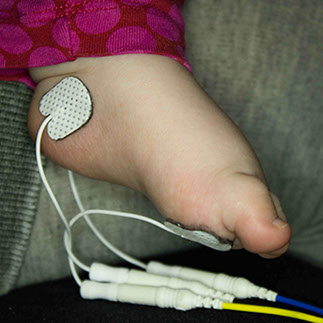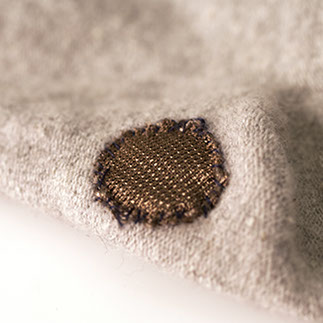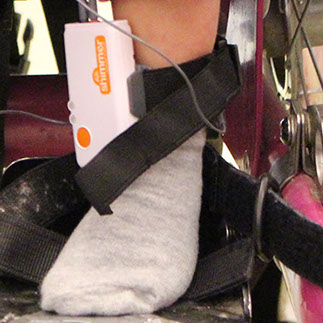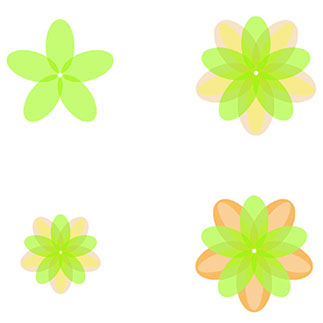Skin conductance
In skin conductance measurements, the amount of moisture (sweat) on the skin is measured. Our sweat production is managed by the autonomic nervous system. This system controls our unconscious bodily processes, for example our breathing. It also serves to activate our body to be able to perform an action. A functionality, supposedly a remainder of prehistoric times, is the so called 'fight or flight' reaction. When you are confronted with a major threat, you have two options: either you fight or you flight. Whichever option you choose, your body needs to be ready to undertake action; thus your body is being prepared. Your heartrate and breathing increase, as well as your sweat production. When you are emotional, a similar reaction happens within your body. We all know the feeling of sweaty palms when we are nervous.
The best locations to measure skin conductance are the palms of our hands or the soles of our feet. We chose to measure skin conductance at the feet to keep the hands free to perform daily activities. Traditionally, skin conductance is measured with sticky electrodes (Figure 1). Sticky electrodes need to be replaced every 24 hours and can as a result cause skin irritation. Moreover, the electrodes require a wired connection (generally with a cable length of about one meter) to a sensor, which in turn requires a wired connection to a computer. This sincerely limits your freedom of movement.
The 'smart' sock
That is the reason why we developed a smart sock. The smart sock has integrated textile electrodes that replace the sticky electrodes (Figure 2). The textile electrodes feel like normal fabric and are therefore hardly noticable when wearing the sock. The sock can be used like a regular sock because of the characteristics of these textile electrodes (it can for example be washed in the washing machine). The advantage of the smart sock is that it can be made in every size, therefore it is suitable for both children and adults.
The sensor
Like the sticky electrodes, the textile electrodes require a wired connection to a sensor. We used a sensor that can be worn around the ankle using a small strap. The connection of the sensor to the computer is wireless (via Bluetooth). This wireless connection also enables connecting the sensor to a tablet or smartphone (for more information on the sensor, please visit the manufacturer's website: www.shimmersensing.com). As is visible in Figure 3, the sensor is still (too) large when the sensor is worn by young children. However, we hope that with the current rapid development in technology we will in the near future be able to offer smaller sensors, which will considerably improve the quality of our system.
The Flower app
To be able to measure skin conductance is relevant, however it only becomes usable when we can see the data. To vizualise the skin conductance data measured by the smart sock, we created the Flower app. The Flower app shows the skin conductance in the shape of a flower. As explained before skin conductance reflects emotions. When the emotion become more intense, for example one becomes more stressed, the skin conductance increases and the flower increases in size. When the stress decreases, the flower's size decreases. However, skin conductance not only can inform us about the intensity of emotions, but also about our response to stimuli from the environment. When someone calls your name, your skin conductance changes. Sounds in the background cause the same effect. The flower vizualises this response to stimuli through showing additional flower petals. The stronger the reaction to stimuli, the better the flower petals are visible.
Changes in the flower (both size and the visibility of additional petals) can be the result of liking something or from disliking something. It is not yet possible to reliable distinguish between positive and negative emotions from skin conductance measurements in our daily environment. However, the Flower app can result in more awareness from the parents/caregivers for a change in the child's/client's emotions and is an invitation to parents/caregivers to look more closely at the signals the child/client shows.

Figure 1

Figure 2

Figure 3

High arousal, no reaction
High arousal, little reaction
Low arousal, little reaction
High arousal, strong reaction
Figure 4

© 2018
Eindhoven University of Technology
Vrije Universiteit Amsterdam
|
|
Department of Industrial Design
Department of Behavioural and Movement Sciences
|
|
Future Everyday group
Clinical Child andFamily Studies section



